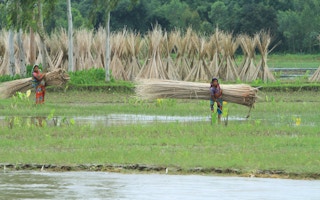Floods are becoming fiercer and more frequent—and sometimes catastrophic. Across Asia, where millions of households still depend on farming for their livelihoods, extreme weather is causing increasing chaos for farmers.
Entire harvests have been wiped out, leaving smallholder farmers with little means to support their families or rebuild. And with Covid-19 impacts racing across the globe, it leaves local communities with a potential double dose of vulnerability.
But scientists, governments and insurance providers have teamed to develop insurance to help farmers recover and rebuild. Weather-Index Insurance (WII) bases payouts primarily on satellite images.
For example, after extreme rainfall, satellite images can help predict and pinpoint damages. Farmer losses can be calculated quickly and accurately, leading to quicker payouts—and faster recovery.
Insuring the smallholders in this way has potential to underpin food security and economic growth for millions. Yet the most vulnerable can be often overlooked in weather-based insurance schemes.
“
“The people who need [weather-based insurance] the most are the least likely to understand its workings, meet eligibility criteria and afford the premium. Overcoming this requires insurers to understand the heterogeneous nature of farming communities, and engage the different people residing within them—from the illiterate, to tenant farmers, to women.”
Sanjiv de Silva, researcher, International Water Management Institute
Lower income and female farmers often lack the means and connections to access the services. So how can insurance companies make sure they are reaching these least advantaged farmers?
A new paper published by the International Water Management Institute (IWMI), with support from CGIAR Water, Land and Ecosystems (WLE), examines schemes in Asia and globally and presents a new framework for insurers and implementers to reach disadvantaged groups when marketing these products.
“It’s not like selling car insurance to the likes of you or I, where we understand what the product is and know where to obtain it,” said Sanjiv de Silva, researcher at IWMI, and one of the co-authors on the paper.
“The people who need it the most are the least likely to understand its workings, meet eligibility criteria and afford the premium. Overcoming this requires insurers to understand the heterogeneous nature of farming communities, and engage the different people residing within them—from the illiterate, to tenant farmers, to women.”
Affordable insurance
Weather-Index Insurance (WII) products use pre-designed indices—such as flood depth and duration—to set payment triggers and verify claims. The indices are developed using data from satellite images and/or weather stations.
This avoids the need for extensive field visits to check claims, keeping premium costs at levels that smallholders can afford. However, uptake of such products means farmers need to have access to the insurance and understand complex concept of the index and how it will be used to verify claims.
Literacy within farming communities is therefore an important consideration for WII vendors. An IWMI pilot project in Bihar, India, and a case study conducted in Sirajganj, Bangladesh, highlight a correlation between farmer class and gender, and accessibility of WII. Access declines from large farmers to landless ones.
For example, in Sirajganj, all large farmers interviewed were aware of the product and most small or marginal farmers knew of it, but none of the landless and only 30 per cent of all women had encountered it. The findings in Bihar were similar, with literacy a significant underlying factor in both cases.
In the developing world, women are disproportionately affected by household-level shocks. Crop losses affect women directly through reduced opportunities for earning. And indirectly, if a household has to consume less food, gender norms often dictate that feeding men and boys takes priority.
Despite this, demand for WII products is reportedly low among women. With men also dominating agricultural decision-making, women tend to be less financially literate. This can make it challenging for them to understand WII trigger and compensation levels.
Insurers must also address issues of land title and farmer wealth when designing WII products. Landed farmers who need to apply to obtain paperwork to support an insurance application may struggle to do so within required time frames.
And share-croppers and farmers who lease land to grow crops might not have documentation at all. Wealth, may also influence demand, as an acceptable premium for large farmers may far exceed what landless tenants can pay.
Overcoming barriers
These hurdles can be overcome through better engagement. For example, insurers should continue awareness-raising beyond initial enrollment to ensure smallholders understand the product features and payment conditions. This can help to avoid misplaced expectations.
In a diverse community of smallholders, some people, including those who are illiterate, may find it difficult to understand the insurance. The conventional way of selling a product—of going to a village and holding a community meeting—may not be sufficient.
Verbal and visual tools such as posters, face-to-face meetings, videos and street dramas can help to overcome illiteracy, and get across the complex concepts of the WII.
And using social spaces that women frequent can ensure they are not overlooked. Where no documentation of land title exists, landowners or local government officials can be called upon to verify details provided by farmers to insurance companies.
In Sirajganj, the scientists piloting the insurance reported that face-to-face discussions in courtyards, mosques and marketplaces; street dramas; and videos were effective for engaging small, marginal and landless farmers. All farmer classes and women preferred video to other forms of communication.
Partnering with a local non-governmental organisation (NGO) is also invaluable for understanding local contexts, building product awareness, overcoming farmers’ suspicions of WII products and insurance companies, and supporting farmers’ purchases.
Some farmers reported that the trust they had in the partner NGO influenced their decision to buy WII. The publication of rainfall data in local newspapers, which confirmed the veracity of the weather index underpinning the insurance, also helped to build farmer trust in the insurer.
Finally, ensuring ongoing engagement is vital. Post-payout clarifications can avoid misunderstandings and ensure the insurance has long-term demand.
Yes, these actions will involve additional costs for the insurer, but these measures can also help insurers to develop a larger and more sustained customer base—a reward for the extra investment.
Realising potential
The economic and development gains from wide-scale implementation of WII are potentially considerable. In South Asia, for example, floods affect 27 million people annually, and cause economic losses exceeding USD 1 billion.
The severity of impacts from such disasters is linked to the region’s high dependence on smallholder agriculture for livelihoods. However, successful, scaled-up implementation of WII is dependent on insurers recognising the differences among farmers.
“Insurance companies may incur more upfront costs by following our framework and conducting in-depth research into local contexts,” said de Silva. “However, they will be investing in a broader and more sustained clientele. If they don’t take these steps, and sections of the population are excluded from learning about their products as a result, they’ve lost part of their potential market right from the outset.”
Mohamed Aheeyar is a researcher with the International Water Management Institute (IWMI), working with support from CGIAR Research Program on Water, Land and Ecosystems (WLE). The work cited was co-authored by IWMI/WLE’s Sanjiv de Silva, Sonali Senaratna-Sellamuttu and Indika Arulingam.









